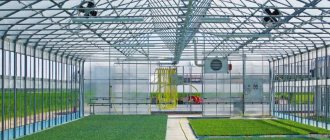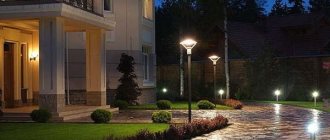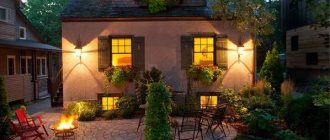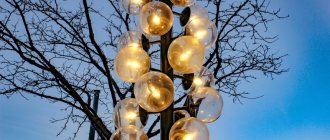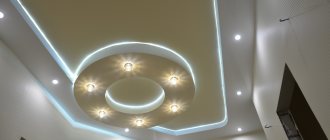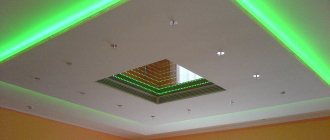People who have a plot of land with a house like to spend time outside in the evening when it’s warm. It could be a party with friends outdoors or work.
A cozy color and pleasant impressions are created by the arrangement of night lighting of the facade of the house and the territory of the site. Some people believe that lighting with ordinary light bulbs will be enough, but to create unique lighting, you need to be prepared to spend money.
There are many options for installing lighting in a summer cottage. Suitable lighting can be selected based on a photo of the lighting of the area.
A man who understands electricity can make lighting in his dacha himself, using creativity and imagination.
Marking
This type of light illuminates decorative figures and the territory of the dacha.
The illuminated elements include: steps into the house, benches, and a parking area. This lighting often uses lanterns with short legs and hanging lamps.
Security lighting
The main purpose of this lighting is to protect against thieves. Spotlights of this type of light are installed to illuminate the threshold of a building, entrance gate, or parking area.
There are general lighting floodlights, but to make it look like someone is in the house and to scare away thieves, they install motion sensors.Lighting decorative features of the house
They use the light of lanterns, lamps and fixtures for placement in certain parts of the territory to emphasize the design near lakes and gazebos.
Such light devices play an important role in illumination and decoration. Now you can find many different lamps of this type.
Scheme of external lighting of a summer cottage
As you understand, examples of site lighting depend on the area of the site, its shape, your need for lighting, types of lighting, control scheme and many other parameters.
Moreover, many of them are quite subjective and even the most approximate scheme will be only partially correct. Therefore, we will consider only the basic rules for forming an external lighting network.
So:
- First of all, this is the distribution panel. PUE standards recommend sharing loads. Therefore, the ideal option for household needs and outdoor lighting would be to organize your own distribution panel, which will be connected directly from the meter.
- The number of groups in an external lighting network is calculated in the same way as for an apartment or house, so we will not focus on this issue. Fortunately, there are more than one instructions on this topic on our website.
- If your control circuit involves the installation of timers, light sensors, starters and other similar equipment, then it is better to place it inside the distribution cabinet.
Note! When we talk about light sensors, we mean devices with a remote sensor and a stationary actuator. They are now quite widely represented on the market.
Light relay with remote element
- In addition to group circuit breakers, we recommend installing an RCD circuit breaker on each group of outdoor lighting. The PUE standards do not require this, but for safety reasons it certainly won’t be superfluous. This is especially true for lines in which, in addition to the lighting network, it is planned to install sockets.
Now regarding the wiring. It can be done underground or overhead, as shown in the video.
So:
- If you plan to install the supply wiring underground, then according to clause 2.1.78 of the PUE, this cannot be done in steel pipes and ducts. To protect against mechanical damage in this case, we use plastic pipes or corrugation (see How to choose metal corrugation for wiring).
- If you plan to install overhead line wiring, then the height of the wire at the bottom of its sag according to clause 2.1.76 of the PUE should not be less than 3.5 meters. And above the road it’s even 6 meters.
- When laying wires along the facades of buildings, you should adhere to the standards of clause 2.1.75 of the PUE, shown in the photo. In this case, in all cases, laying wires on the roof of the building is prohibited.
- Distribution boxes, switching devices and lamps must have a protection class corresponding to outdoor installation. Usually this is IP44 and higher.
What to consider when planning external lighting for your dacha
In order to install street lighting in a summer cottage at night, you need not only to choose lanterns, but also to take care of drawing up a plan for the placement of support pillars throughout the entire territory.
You also need to outline the directions for laying cables in the ground. The lighting zones and places for connecting electrical cables of each lighting device should be marked.
To do this, install water-protected sockets or switching boxes. The owner of the site will decide where the switches will be located, based on ease of use.
To apply the lighting scheme, you should use a copy of the layout of your site. If it is not there, you need to make a plan with a scale of 1:100 and place all the buildings on it.
The lighting scheme is arranged taking into account the planned landscape design. Seating areas and garden paths should also be placed.
Landera power supply project: what does it include?
When organizing the lighting of an area in landscape design, first of all you should focus not only on prices and how quickly the contractor will do the work, but on the professional approach and competence of the staff. In the Landera studio, all agronomists, architects and designers have specialized education, which allows them to develop a lighting project according to the canons and rules. We include the following in the electrical supply project:
- Schematic diagram.
- Single line diagram.
- Route plan.
- Explanatory note to the diagram showing the future system.
- Lamp arrangement plan.
- Electrical equipment specification.
- The final estimate for the system installation.
Important! Your design project will become complete only with the correct lighting arrangement. The light will favorably emphasize the advantages of the site and hide its shortcomings.
What to include when drawing up a lighting scheme
The future locations of the lanterns are schematically plotted. Often the location on the map is written with the letter L. The location of these switches is also indicated - B. The sockets are indicated - R.
When a project is being done, you need to focus on the illumination of the entrance to the house and the gate to the site. When installing, it is worth considering the height of the lamps so that they are not covered with snow in winter.It is not recommended to use lighting on fences due to the blinding, powerful light of spotlights. The choice of how to implement street lighting in a suburban area remains with the owner.
If you cannot properly illuminate your suburban area, then you should ask for help from specialists who will provide you with high-quality lighting near your dacha.
Basic lighting options for a dacha
It is worth considering that the lighting of a summer cottage can have different functions, and therefore, depending on one or another option, it is necessary to select all lamps according to the type of their purpose. There are several types of lighting in a suburban area:
- General. The main function of this lighting is to organize visible zones on the site for safe movement in the dark, as well as carrying out various works and spending free time. Lamps intended for these purposes should be installed near the entrance to the house, along garden paths and near the entrance to the territory.
- Marking. This type of lighting is usually used to emphasize some decorative elements and landscape of a summer cottage. These can be steps, benches, boundaries of a parking space for a car, etc. Most often, lanterns on small legs, “glowing stones,” and pendant lamps are used for such lighting. It is better to use lamps that have LEDs. This will allow you to save on electricity and choose the necessary colors for the lighting.
Marking type of lighting
- Security. The main task of such lighting of a country house and the surrounding area is to protect the area from intruders. Such lamps are installed so that all main areas are illuminated: the threshold of the house, garage and entrance gates, and parking spaces. General-purpose flashlights can be used, but for a surprise effect, motion sensors are used, which create the impression of a person’s presence in the house. It is possible to configure the operation of the lighting system or its individual elements in automatic mode. This is possible thanks to the installation of a time relay, which will turn on specific lighting groups at a given time.
- Decorative. This type of lighting includes lamps, lamps and lanterns, which are installed mainly in places where it is necessary to emphasize landscape design, near bodies of water, in areas where people spend their leisure time. Such lighting devices are not aimed at illuminating the area, but only serve as lighting and decoration. Currently, there are many lamps of this type, for every taste and color.
Use of decorative lamps
Landscape area lighting
To create light in the territory of a dacha, ground lamps are often used. These devices have a metal body, they shine with white light and are installed in the ground, illuminating only the paths. These lamps have low power consumption.
To create landscape lighting for an area, decorative illumination on posts is also used, which provides soft light. They outline the boundaries of garden paths and highlight the area in the country.
There are devices powered by solar panels. Landscape lighting at the dacha includes lighting groups: for trees, on the lake, for sculptural items.
Examples of decorative lighting for flower beds and landscape compositions
Let's look at how you can organize garden lighting using specific photographic examples.
Flowers in luminous containers
Glowing flowerpots
The composition of flowers in garden pots decorating the gazebo includes three flowerpots with built-in LED lighting. During the day they do not stand out in any way, but at night they turn into bright luminous balls. The lamps operate on rechargeable batteries and provide soft, diffused light that floods the flower beds and lawn. Flowers planted directly in luminous containers look unusual - they seem to float in the air.
Composition with amphorae
Accent lighting of the composition on the lawn
The all-round composition, located on the lawn, is illuminated by several spotlights. One of them is installed on the ground and focuses attention on the amphora, the second is slightly raised and directed towards the treetops. As a result, the entire composition is presented in subdued light, while the most interesting details are brightly lit.
Japanese style garden corner
Japanese lantern on the shore of a pond
To illuminate the coastal area of the garden pond, we chose a Japanese lantern mounted on a large stone. Its bright diffused light beautifully emphasizes the silhouette of plants growing along the edge of the pond, but, most importantly, the lamp itself serves as an interesting decorative element and looks like a small lighthouse. The water mirror is immersed in twilight, reflecting only the light pouring from the lantern.
Snowy pine effect
Illumination of a flower bed with conifers
Using a dazzling white spot light to illuminate a conifer composition creates the optical effect of frost-covered pine needles. Several lamps are installed around the perimeter of the flowerbed and form bright spots of light, others are placed in the crown of the plants and illuminate them from the inside.
The magic of white and blue tones
Decorative lighting for a relaxation area with a swimming pool
The play of light and shadow combined with the blue mirror of the pool and the jets of water in a small waterfall makes this relaxation area spectacular in the dark. Shrubs and conifers, illuminated from below by small spots of light, look very atmospheric and mysterious.
Colorful tree illusion
Illumination of a tree with multi-colored lights
Just two LED lights with color filters placed on the ground and pointed upward create a stunning multi-colored tree effect. It looks like a fairytale giant wandering into the garden. Use such lighting with caution and in doses so that your garden does not sparkle like the entrance to a casino.
Contour lighting of the flower bed
Contour lighting of the flower bed
And this photo shows an example of LED strip lighting. It is located along the contour of the flowerbed and forms a contrasting border of light and darkness. Since the radiation is directed into the flower garden, but the background is in the shadow, the rays perfectly emphasize the silhouette of the plants, but blur the color scheme and the composition is perceived in black and white.
Chinese lanterns in garden design
Lighting a flower bed with Chinese lanterns
To illuminate the lawn and flower beds located along its perimeter, we chose conventional flood lighting, but took an unconventional approach to the choice of lamps. These are decorative Chinese lanterns hung on a tree. Glowing balls emit soft diffused light and look very romantic. The design is complemented by several spot light spots, focusing attention on the garden waterfall and individual plants.
Intersecting light illumination
Pond illumination
To illuminate the cascading reservoir, they used a simple technique - they installed small spotlights opposite each other and directed the rays so that they intersected at the point where the water was pouring out. The result is a stunning effect - it seems as if the light itself is flowing, like molten gold.
Lanterns on poles located along the perimeter of the reservoir gently flood the surrounding landscape, creating smooth transitions from light to shadow.
Recreation area lighting
Illumination of the relaxation area in the garden
In conclusion, we have selected a photographic example where several types of decorative lighting are used at once. LEDs built into the retaining wall gently outline the site's contours. Spotlights with colored filters paint the tree crowns red, yellow and white. Additional lighting is provided by the fire in the garden fireplace, filling the area with atmospheric light and pleasant warmth.
In this article, we focused on the aesthetic component of decorative lighting, but it is important not to miss the technical aspects of organizing landscape lighting. You can read more about this here and watch the video.
Country decorative home lighting
Why do owners want to have decorative lighting for the walls of their home?
Firstly, to highlight the features of the facade of the house. To do this, they use directed light on the walls of the building using various LED strips, yellow light lamps, they are fixed directly on the walls of the building.
Secondly, to protect your home. Then your house is flooded with bright lanterns, which are installed at a distance from the house. For this purpose, halogen lamps are used.
Nuances of landscape plant lighting
To emphasize the unusual shapes of plants and the richness of the color of their foliage, a variety of light sources are used. Their design is selected in accordance with the assigned tasks and with an eye to the current season. Despite some disadvantages, it is still recommended to use unsightly, by today's standards, incandescent lamps when illuminating vegetation. Spotlight illumination with mercury light carriers is also suitable. They will give the leaves a pleasant turquoise hue.
Mercury lamps will give plants a turquoise hue.
The ability of lamps to produce a specific, unique color spectrum of light will help create interesting color effects. Try lighting flower beds in landscape design with fluorescent lamps, trees with mercury lamps, and shrubs with Ilyich lamps, and see what a magnificent sight appears before your eyes. You can illuminate bushes and trees by installing lamps on the ground, somewhere on the trunk or under the crown itself. The second and third options are relevant for single plantings. The internal glow emphasizes the beauty of the crown shape and makes the object clearly visible against the background of a dark planting mass or sky. Illumination from below and from behind makes the contours of the plant clearly visible.
The internal glow emphasizes the beauty of the crown shape
Incandescent lamps are recommended for use in landscape lighting for floodlights, not only in the spring-summer season. They remain relevant in autumn, when the foliage changes color, becoming crimson-yellow. But in winter, snow-covered branches will look better in the rays of colored light streams. They will create a festive mood in the garden. Bare branches will look good highlighted by landscape lighting coming from the background, that is, from behind them. The beam of light itself will become a kind of background, and the bare trees will stand out as sophisticated dark silhouettes. A special approach is recommended for lighting in the landscape design of birch trees. Their whitish trunks are magnificent in the rays of ground-mounted spotlights.
Colored lighting will create a festive mood in the garden
In the context of park decor, it is important to make the right choice of objects to be illuminated. Here you need to put on display architectural dominants, entrance lobbies, platforms, the most attractive plantings and leave everything ordinary in the shadows. Here, the play of contrasts will come first in the lighting of landscape design, since it is precisely this that is responsible for the volume of visual perception of the presented composition. A certain contribution to this will be made by light strips and neon inscriptions available in the design of arches and attractions.
Highlighting architectural dominants will give the landscape depth
It is more correct to highlight three-dimensional structures, decorative sculptural compositions, obelisks and monuments in landscape lighting using sources of directional light. Typically, spotlights standing on low stands, hidden in concrete niches, or sunk into the ground are used. Tall trees growing surrounded by dense bushes can be accentuated in the same way. The latter will mask the source of light emission from the eyes of observers. Special requirements are imposed in landscape lighting on interior lamps used in the electrification of premises. They will have double workload. On the one hand, they must illuminate the interiors with high quality, and on the other hand, they must shape the external appearance of the perception of the architectural object.
Illumination of the facade of the house with hidden lamps
To make beautiful buildings more impressive, rays of sliding lighting can be used.
In modern parks, glass pavilions often become luminous objects. These luminaires, which are quite large for landscape lighting, are perceived as impressive as possible if they are located near bodies of water. The reflective ability of the water surface stimulates the play of colors, adding brightness and shine to them with water highlights.
A very interesting solution to lighting problems in park landscape design was found in Munich. There, on an area of 70 hectares, a cable-stayed covering was used, assembled from steel cables and transparent film, which was stretched over the main structures. The enormity of the luminous coating did not make it difficult to perceive. On the contrary, it favorably emphasized the spatial design of the park area landscape as a whole and determined its architectural features.
Lighting in a Munich park
To get the maximum aesthetic benefit from plant lighting, you need to understand what to focus on when planning landscape lighting. First of all, the texture of the trunk, the method of branching, the shape of the leaf, the intensity of the density of the crown, its seasonal color, growth rate, the type of inflorescences and the color of flower petals are important. All these nuances directly affect the choice of type of landscape lighting.
Trees with a dense, impenetrable crown are illuminated by distant light sources. In this way, flood lighting of the tree from the outside is organized. With a transparent crown, lamps can be placed directly on the trunk and direct their light so that it penetrates between the leaves. Illumination of tall trees in landscape design, especially pyramidal shapes, occurs with spotlights, the design of which includes concentrating optics. They are placed no closer than 5, or even 10 meters. It is also recommended to use spotlights when illuminating palm trees. Spots will highlight the crown, and spotlights will have the role of emphasizing the texture of the trunk.
Illumination of tall trees with a dense crown is carried out by spotlights
Dense, rounded crowns, such as those of magnolia, can also be illuminated with distant light. If you need to provide circular illumination, then you should take care of the correct angle of light supply. It should not hit the eyes or give a blinding effect. There will be no restrictions on the angle of lighting in landscape design if the lighting fixtures can be placed in a screening area, that is, in bushes or other low-growing plantings. However, this must be done so that bright highlights do not appear on their leaves.
Circular lighting of trees
Problems with the placement and selection of types of lamps arise most often in young gardens, since here you will often have to adjust the landscape lighting, that is, redirect the devices, and sometimes even move them. A way out of the situation can sometimes be the purchase of lighting structures with height adjustment.
With conifers that are too tall, it can sometimes be difficult to illuminate the entire crown. Experts say that in this case you can limit yourself to its lower illumination. The effect will be no less impressive.
Illumination of coniferous plants is usually done from below
It is no less difficult to organize landscape lighting with lamps for the spreading crown of an oak tree. Since it is extremely voluminous, it is necessary to expand the number and diversify the quality of lamps in its lighting.
A serious problem for lighting in landscape design is the growth of plantings. This, by the way, is the main reason why there is a need for seasonal maintenance. Light fixtures are cleaned, reinstalled, repurposed. In order for the system to work as fruitfully as possible, sometimes it is even necessary to remove some plants that interfere with its functioning. You need to know about this in order to provide a supply of cable during the initial installation. This will greatly simplify the operation of the system in the future and will not become an obstacle to the transfer of lighting devices.
As the garden grows, the lamps are reinstalled
For the same reason, it is not recommended to use built-in landscape lighting fixtures in growing gardens. Uplights are only suitable for mature plantings. Young animals are predominantly illuminated by low-voltage devices mounted on adjustable support pins. Their work is easier to correct. The fact that lighting of trees in landscape design is often done from below is explained by the ease of installation of spotlights, but overhead lighting gives a more natural perception of the plant. It is well recognizable because it looks the same as during the day. With lower-tier lighting, the play of chiaroscuro creates a slightly different effect. Shadow and light seem to be reversed here.
Overhead light is a less contrasting solution. Since a sufficiently large surface of the soil is illuminated, greater consistency of objects arises, which is reflected in an improvement in the emotional perception of the composition. A person can distinguish details, consider the color of foliage. The main obstacle to organizing overhead lighting in landscape design is the lack of supports for installing lighting elements. If there are no suitable buildings, neighboring trees can be involved. Lamps on trunks and crowns will open up combinational horizons, which will free up the hands of designers.
You can install lamps directly on trees
Unusual effects are produced by side lighting of particularly specific trees or original group plantings. They become a magnificent sight against the backdrop of the darkness of the rest of the green area.
Spectacular side lighting of trees
There are a few other subtleties to landscape tree lighting. It is more advisable to highlight small individuals completely, filling them with uniform light. On the crowns of tall and spreading trees, it is more correct to make a series of picturesque light spots that attract with brightness. The best landscape lighting will be provided by lamps with high power incandescent lamps of 300 or even 500 W. Among mercury lamps, you should choose models with a power of 250 W. Each 8-12 meter tree will require at least three spotlights.
Instructions for installing external lighting in a country house
When there are instructions on how to arrange light on the street, then it is easier to make high-quality lighting for the dacha area.
Preparing the area for installation of supports. Debris is removed where the cable will be laid. The necessary tools are prepared and the required material is purchased. Set of tools: shovel, cement, screenings, water.Calculate the required outdoor lighting. Decide on the total number and power of lights, cable length, switch power, and RCD.
You will need to make a street lighting diagram for the site. To do this, use your site plan with the area, all buildings and laid communications. Take the copy of the plan you made and draw your diagram.
Install outdoor lighting poles. For wall-mounted devices, lamp supports must be installed in the walls.
To install vertical lamp posts, you will need to pour a foundation. Fix the lights on the poles and connect them to the electrical wires, where it is planned to install the necessary switches.
Connect all wires and insulate them. Check the existing wire connections, resistance 0 to the phase, then check the presence of power supply.
Functional garden lighting
The main idea of creating functional lighting on a site is to make it safe to move around its territory in the dark. And for this it will be necessary, first of all, to resolve the issue of high-quality lighting of garden paths.
Garden path lighting
This means that you will have to highlight not only the central alley, the passage from the gate to the porch, but also smaller paths leading to areas where the owners may need access in the evening, but it will be necessary to install garden lighting on each specific site -different. The entrance group, for example, is usually decorated with tall lanterns of a pillar structure, which today can be found in a wide variety of styles, from high-tech to vintage. You can see what each option looks like in garden lighting in the photo.
Entrance lighting
Functional light should literally flood the entire area, but not cause inconvenience, so experts recommend that those who decide to work on garden lighting with their own hands should use lamp posts with a height of 2 meters or more for the design of their home landscape. Lower structures, 1.5 - 2 m high, are not entirely convenient, since their lamps will shine directly into people's eyes, and a blinded person can navigate the terrain even worse than in the dark. What kind of security is there!
Lanterns with a height of 2 m will create soft diffused light
Lighting in the garden area is subject to any obstacles present in its landscape:
- rises;
- depressions;
- stairs;
- bodies of water
Light up all obstacles in the garden
Light on stairs should be focused on each step. Spot-type lamps, as well as structures in the form of columns or tubes, will help to achieve this effect. If they are positioned well, the object will not only be well lit, but will turn into a magical path leading into a fabulous distance. You will want to walk up such stairs.
Staircase lighting with spotlights
What lamps to use in garden lighting
“Of the modern options, perhaps the most appropriate lighting for the garden will be provided by LED lamps”
Typically, high-power incandescent lamps are installed in garden lighting lanterns, but since they require frequent replacement, many summer residents prefer their halogen and gas-discharge counterparts. Such products have more intense light emission with minimal energy costs. However, these modern solutions are not without their drawbacks, so if you make garden lighting yourself, you need to know and take them into account.
Gas discharge lamps produce intense light with minimal energy consumption
Gas-discharge types of lamps are not used where frequent switching on/off of lamps is required and in structures with motion sensors. Firstly, they need time to accelerate (that is, they do not light up immediately, but gradually gain power), and secondly, they are not ready for voltage drops. Halogen lamps get too hot, so they should not be installed close to plantings unless you want tree leaves to get burned or plants to completely die. Of the modern options, perhaps the most appropriate lighting for the garden will be provided by LED lamps. Although they are more expensive, they are also noticeably more productive in their capabilities, although the choice, of course, is yours.
Garden lighting with LED lamps
This is interesting: Paving slabs for a summer residence: how to make the right choice (24 photos)
Photo of site lighting
Please repost
0


